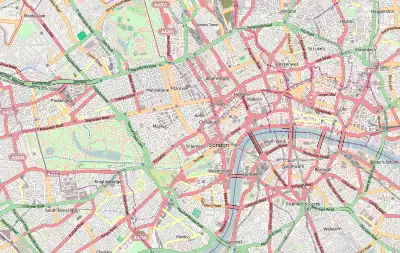Victoria Coach Station | |
|---|---|
 Victoria Coach Station, 2012 | |
| General information | |
| Location | Buckingham Palace Road Victoria, London, SW1 England[1] |
| Coordinates | 51°29′35″N 0°08′55″W / 51.4931°N 0.1486°W |
| Operated by | Transport for London[1] |
| Bus stands | 22[1] |
| Bus operators | 15[1] |
| Connections | Victoria |
| History | |
| Opened | 10 March 1932[2] |
| Passengers | |
| 14 million (2016 / 2017)[3] | |
| Location | |
 Victoria Coach Station Location within Central London | |
Victoria Coach Station in the City of Westminster is the largest coach station in London, and a terminus for medium and long distance coach services in the United Kingdom. It is operated by Victoria Coach Station Limited, a subsidiary of Transport for London. As of 2017, there were 14 million passenger and 472,000 coach movements annually.[3]
Victoria Coach Station covers 3.3 acres (13,000 m2) with separate arrival and departure terminals on opposite sides of Elizabeth Street. The departure building includes food and retail outlets, left-luggage facilities and a ticket hall.[4]
London Buses routes 11, 44, 170, 211, C1, C10, N11 and N44 serve the coach station. It is a short walk from Victoria railway station.[1]
History
Victoria Coach Station was commissioned by London Coastal Coaches, a consortium of coach operators, and opened on 10 March 1932 by Minister of Transport John Pybus.[2] Wallis, Gilbert and Partners' distinctive Art Deco building[5] was originally built with spaces for 76 coaches, and a booking hall, shops, buffet, restaurant, lounge and bar. London Coastal Coaches' headquarters and other offices occupied upper floors.[6]
During World War II coach travel was restricted and the War Office requisitioned the premises.[7]
By the 1960s, operation of the station had passed through industry consolidation to Tilling Group and British Electric Traction, whence it was reorganised by the Transport Act 1968 to become part of National Bus Company. Subsequently it was transferred to London Transport in 1988, and Transport for London in 2000.[7]
Freehold owner, Grosvenor Group, announced in 2013 that it wished to redevelop the site and relocate station operations elsewhere in London,[8] though the following year English Heritage designated the building Grade II listed.[9] Nevertheless, several of Transport for London's leases on the station were due to expire by 2023 and proposals were made to relocate to Royal Oak, but in 2019 the move was abandoned.[10][11]
Utilisation
Use of the coach station has increased from 2008 to 2018.[12][13][14][15][16]
| Passengers - million | Coaches - thousand | |
|---|---|---|
| 2021 / 2022 | 11 | 118 |
| 2020 / 2021 | 2 | 40 |
| 2019 / 2020 | 13.2 | 440 |
| 2018 / 2019 | 12.5 | 450 |
| 2017 / 2018 | 14 | 472 |
| 2016 / 2017 | 14.5 | 476 |
| 2015 / 2016 | 14.5 | 466 |
| 2014 / 2015 | 14 | 460 |
| 2013 / 2014 | 14 | 480 |
| 2012 / 2013 | 11 | 438 |
| 2011 / 2012 | 10.5 | 413 |
| 2010 / 2011 | 10.3 | 399 |
| 2009 / 2010 | 11.8 | 389 |
| 2008 / 2009 | 9.5 | 394 |
Data from 2008/2009 until 2019/2020 is for departing passengers only and both departing and arriving coaches.
Data from 2020/21 onwards is 'passenger movements through the site' and 'Domestic and International Accessible Departures'. TFL does not state a reason for the reporting being different.
Operators
As of 2023, service operators include:-[17]
| Operator | Image | Routes operated |
|---|---|---|
 |
Lille and Paris | |
 |
||
 |
Various International & Domestic routes | |
_and_54277_(YX66WNH).JPG.webp) |
Various Domestic routes | |
.jpg.webp) |
Various Domestic routes | |
| Various destinations in Poland | ||
Financial
Profits for Transport for London subsidiary, Victoria Coach Station Ltd have increased over recent years.[12][13][14][15]
| Revenue - million | Profit - thousand | |
|---|---|---|
| 2017 / 2018 | £9.9 | £1,300 |
| 2016 / 2017 | £10.0 | £1,200 |
| 2015 / 2016 | £9.5 | £494 |
| 2014 / 2015 | £9.2 | £123 |
| 2013 /2014 | £8.9 | £654 |
| 2012 / 2013 | £8.6 | £419 |
| 2011 / 2012 | £8.4 | £727 |
Controversy
In 2019, Transport for London was served a Fire Enforcement Notice after a "catalogue of major fire risks" were found by London Fire Brigade inspectors at Victoria Coach Station.[18]
The deficiencies included holes in walls, which could cause a fire to spread; inadequate fire sprinkler systems that had been broken and out of use for more than two years, and obstructed exit routes used for storage. Fire experts described the situation as a "walking disaster area" and "by far the worst I've seen in a long time". Transport for London posted fire watchers.[18]
References
- 1 2 3 4 5 6 "Victoria Coach Station". Transport for London. Archived from the original on 4 January 2023. Retrieved 1 January 2023.
- 1 2 "New Coach Station Opened". The Times. No. 46079. 11 March 1932. p. 9. Archived from the original on 10 January 2023. Retrieved 27 August 2022 – via Gale Primary Sources.
- 1 2 Annual Report and Financial Stements for the year to 31 March 2017 (Report). London: Victoria Coach Station Ltd. 2017 – via Companies House.
- ↑ Annual Report for year ended 31 March 2014 (PDF) (Report). Transport for London. 2014. Archived (PDF) from the original on 4 January 2023.
- ↑ "Victoria Coach Station – Celebrating 75 years of service". Transport for London. Archived from the original on 25 April 2012. Retrieved 26 January 2010.
- ↑ "Victoria Coach Station". Historic England. Archived from the original on 9 May 2019. Retrieved 9 May 2019.
- 1 2 "Coaches". Transport for London. Archived from the original on 1 January 2023. Retrieved 1 January 2023.
- ↑ Spittles, David (21 August 2013). "Victoria's £2-billion transformation as its coach station becomes a cultural quarter with homes, shops and arts venues". London Evening Standard. Retrieved 21 August 2013.
- ↑ Historic England (1 September 2014). "Victoria Coach Station Ltd, 164 Buckingham Palace Road, London, SW1W 9TP (Grade II) (1418262)". National Heritage List for England. Retrieved 2 September 2014.
- ↑ Prynn, Jonathan (23 August 2019). "Victoria Coach Station: Plans dropped to move transport hub from its historic home after backlash". London Evening Standard. Archived from the original on 4 January 2023. Retrieved 24 July 2022.
- ↑ Prynn, Jonathan (14 March 2019). "Plan to relocate Victoria coach station to Royal Oak is scrapped". London Evening Standard. Archived from the original on 10 January 2023. Retrieved 24 July 2022.
- 1 2 Annual Report and Financial Stements for the year to 31 March 2018 (Report). London: Victoria Coach Station Ltd. 2018 – via Companies House.
- 1 2 Annual Report and Financial Stements for the year to 31 March 2016 (Report). London: Victoria Coach Station Ltd. 2016 – via Companies House.
- 1 2 Annual Report and Financial Stements for the year to 31 March 2014 (Report). London: Victoria Coach Station Ltd. 2014 – via Companies House.
- 1 2 Annual Report and Financial Stements for the year to 31 March 2012 (Report). London: Victoria Coach Station Ltd. 2012 – via Companies House.
- ↑ Annual Report and Financial Stements for the year to 31 March 2010 (Report). London: Victoria Coach Station Ltd. 2010 – via Companies House.
- ↑ "Coach companies". Transport for London. Archived from the original on 4 January 2023. Retrieved 25 May 2015.
- 1 2 Ahmed, Samah (2019). "A catalogue of fire risks found at Victoria Coach Station". IFSEC Global. Retrieved 1 January 2023.